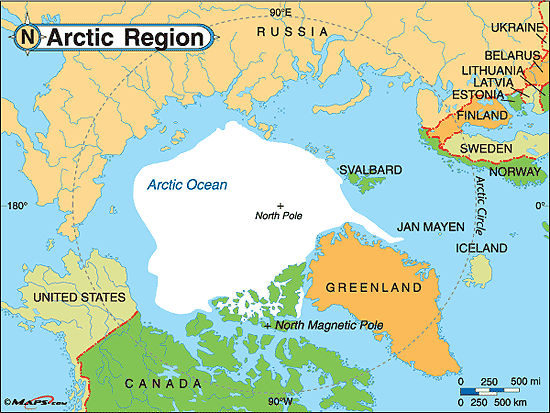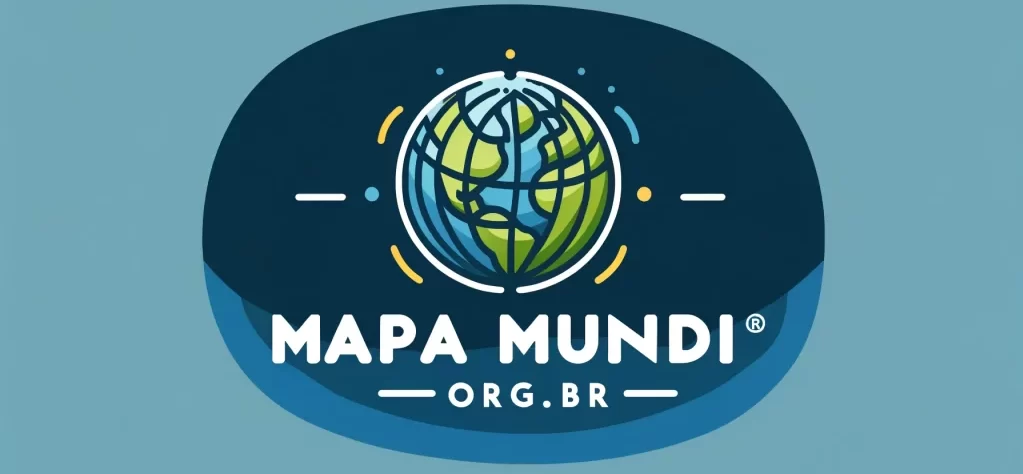
Pesquisas recentes indicam que o buraco da camada de ozônio diminuiu no Hemisfério Sul, porém se abriu no Hemisfério Norte. Para se ter uma ideia, o aquecimento global na região é duas vezes mais intenso do que a média global. Além dos possíveis impactos ambientais, essa é uma região que deverá chamar mais a atenção do mundo.
A Região Ártica é reconhecida como a região do Hemisfério Norte no qual a temperatura média do mês mais quente do ano não ultrapassa os 10ºC. Projeções indicam que haja algo em torno de US$ 35 trilhões em reservas de gás e petróleo na região, além de outros recursos minerais. Em função disto, há uma disputa entre os países da região em termos de domínio pelos recursos.
Diversos países fazem “fronteira” com a região ártica. Os dois países com maior fronteira com a região são Canadá e Rússia, esta com 53% das fronteiras marítimas do Ártico. Em termos populacionais os russos representam aproximadamente 2 milhões, dos 4 milhões que vivem na região.
Os gastos militares russos têm diminuído ao longo dos últimos anos. Atualmente Rússia não está entre os 10 maiores consumidores mundiais de artigos militares. No entanto, quando se percebe um aumento da presença militar russa na região, iniciam-se as especulações sobre as razões disto. Alguns analistas acreditam no desenvolvimento de uma nova fronteira de embate entre a Rússia e Ocidente, exatamente na região ártica.
Esse tipo de visão procura recuperar a leitura clássica da Guerra Fria, na qual o avanço de um lado deve, necessariamente, significar o aumento da ameaça a outro lado. No âmbito da OTAN (Organização do Tratado do Atlântico Norte) tem crescido a visão de que a retomada da militarização russa na região seria uma forma de o país manter uma vantagem geopolítica, considerando o posicionamento estratégico da região no globo terrestre.
Entretanto, ao se analisar um cenário que vai além apenas da dimensão militar, procurando entender também dimensões como as econômica, política e cultural, pode-se perceber que há uma outra movimentação importante ocorrendo.
A Rússia hoje desempenha o principal papel político-econômico na região. Para se ter uma ideia, um dos maiores projetos de gás natural liquefeito do mundo é hoje desenvolvido pela Rússia na região, chamado de Yamal. Ao mesmo tempo, o governo russo tem incentivado a produção energética na região, como a anunciada renúncia fiscal de aproximadamente US$ 40 bilhões para empresas que queiram atuar na região (o anúncio foi realizado em outubro de 2019).
O resultado destes investimentos é significativo. Espera-se que a Rússia passe a produzir na região algo em torno de 100 milhões de toneladas de petróleo anualmente. Isso significa em torno de 20% da atual produção total da Rússia.
Outro interessante projeto que mostra a mudança no perfil da presença russa na região é a Rota do Mar do Norte. Trata-se de uma passagem antes utilizada como um viés geopolítico importante e que, agora, começa a ser utilizado como uma rota de transporte de cargas entre a Ásia e a Europa. Basicamente essa seria uma alternativa à clássica rota marítima, pelo Canal de Suez. O uso desta nova rota permite a redução em 15 dias no transporte. O nova rota ainda está em desenvolvimento e exigirá muita adequação e com uma lucratividade ainda incerta, mas tem ganho importância crescente perante o governo russo.
Os custos da presença russa na região são grandes, especialmente considerando um país que têm pressões crescentes para direcionar recursos para a atividade econômica, manutenção do emprego e das aposentadorias.
Os diversos interesses (militares, econômicos, políticos) na região, ao mesmo tempo em que levam a expectativas tendencialmente conflituosas, também criam espaço para colaboração. Existem várias organizações, conselhos e movimentos que buscam a promoção de temáticas e a defesa de interesses comuns da região. Dentre os vários esforços, pode-se destacar o Fórum Internacional Ártico (https://forumarctica.ru/en/).
O que se pode notar com esses movimentos é o esforço para que as diversas agendas possam ser minimamente compatibilizadas. É o exemplo do esforço em torno de um acordo entre os países da região para que haja um equilíbrio entre o impacto ambiental e a exploração dos recursos da região.
Num mundo complexo como o que vivemos, tentar reduzir a região do Ártico à geopolítica é perder a real dimensão do que está ocorrendo. As agendas são múltiplas não só pela quantidade de atores envolvidos, mas sobretudo em função da quantidade de temáticas e a forma como se influenciam.
Pós-Doutor em Competitividade Territorial e Indústrias Criativas, pelo Dinâmia – Centro de Estudos da Mudança Socioeconómica, do Instituto Superior de Ciencias do Trabalho e da Empresa (ISCTE, Lisboa, Portugal). Doutor em Relações Internacionais pela Universidade de Brasília (2007). É Diretor Executivo do Mapa Mundi. ORCID https://orcid.org/0000-0003-1484-395X
